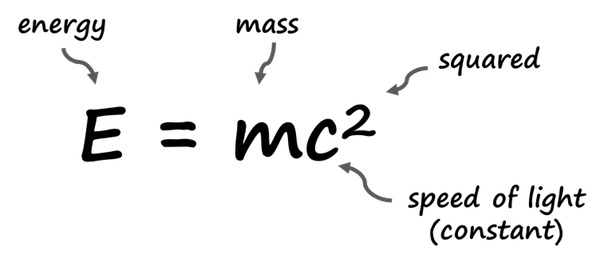Albert Einstein’s equation E=mc² is arguably one of the most famous equations in the history of science. This formula describes the relationship between mass (m) and energy (E), they are interchangeable, and the amount of energy contained in a given mass is proportional to his square of the speed of light (c). Is showing. This equation is often used in the context of nuclear physics and atomic energy, but it has far-reaching implications well beyond the realm of elementary particles.
One of the deepest implications of E=mc² is to emphasize the interrelationship of all matter and energy in the universe. Simply put, everything is made of energy. Even the most solid and tangible objects in the world, including our own bodies, are essentially bundles of energy held together by the forces of nature.
But did you know that each of our bodies is also proof of Einstein’s equation?
To understand this concept, we need to break down the equation and examine its component. Energy, Mass and Speed Of Light are the main components. This equation essentially states that energy and mass are interchangeable, and that an object’s energy content is equal to its mass times the speed of light squared.
At first glance, this may seem like a complex concept that has little to do with our daily lives. But when we look at how our bodies work, we find that Einstein’s equations are at work all the time.

Then What Is ENERGY?
Energy is another basic term in physics that refers to the ability of a system to do work. Energy comes in many forms, including kinetic energy (energy of motion), potential energy (energy of position), thermal energy (energy of heat), and electromagnetic energy (energy of light). Each of these forms of energy can be converted into other forms of energy or mass as described by Einstein’s equations.
The idea that everything is made of energy is not new. In fact, it has been the basis of many ancient philosophies and spiritual traditions for thousands of years. However, the nature of energy and its relationship to mass was not fully understood until Einstein worked on his theory of relativity.
Let us understand that MASS
Mass is a basic concept in physics that refers to the amount of matter contained in an object. Anything with mass also has gravity, which is the force that attracts objects with mass.
Mass and energy may seem like completely separate concepts, but Einstein’s equations show that they are actually two sides of the same coin. So mass is a form of energy and energy can be converted to mass. The idea was first proposed by Einstein in his famous work on special relativity in 1905, and has been one of the cornerstones of modern physics ever since.
Now The SPEED OF LIGHT
The speed of light is the third and final element of Einstein’s equation. It is a fundamental constant of the universe that describes the speed at which electromagnetic radiation (including light) travels in a vacuum. The speed of light is incredibly fast, about 299,792,458 meters per second, and plays an important role in many aspects of modern physics, including relativity and quantum mechanics.
Einstein’s equations show that the amount of energy contained in a given mass is proportional to his square of the speed of light. This means that even a tiny amount of mass contains a huge amount of energy. For example, if you could convert the entire mass of a paper clip into energy, you could release enough energy to keep a small town running for days.
But How Does This Associate With Our Body
Let’s understand this fact that our bodies operate by the constant flow of blood and our cells and elements of our body that are responsible for our living selves are made up of atoms and these building blocks of everything contain mass and energy
To understand how much energy our body contains, let’s do some simple math. The average adult human body mass is about 70 kilograms. Applying this to Einstein’s equation, we get:
E = (70 kg) x (299,792,458 m/s)²
This equation tells us that the average human mass stores a staggering 6.3 x 10¹¹ joules of energy. This corresponds to the energy released by an explosion of over 150,000 tons of TNT.
Of course, we don’t usually see this energy released in our daily lives. It is important. Every time we move, breathe, or think, we use energy that comes from mass.
So how does all of this relate to our bodies? Our bodies turned out to be a perfect example of the principles described by Einstein’s equations. Each of us is made up of trillions of cells, each containing a tiny amount of mass. Each individual cell contains a small amount of mass, but the total mass contained in our body is It’s huge.
So our body already contains two components and functionality i.e. of mass and energy and the metabolism of our body functions on the foundations of speed of light but isn’t actually as prominent as mass and energy in our body but still is influenced by the mass energy equivalence.
